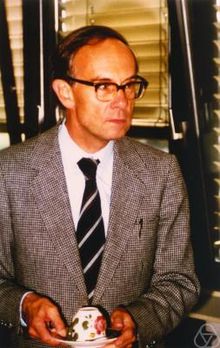Friedrich Hirzebruch
| Friedrich Hirzebruch | |
|---|---|

Friedrich Hirzebruch in 1980 (picture courtesy MFO)
|
|
| Born | Friedrich Ernst Peter Hirzebruch 17 October 1927 Hamm, Province of Westphalia, Weimar Germany |
| Died | 27 May 2012 (aged 84) Bonn, Germany |
| Residence | Germany |
| Nationality | German |
| Fields | Mathematics |
| Institutions | |
| Alma mater | |
| Doctoral advisor | |
| Doctoral students | |
| Known for | |
| Notable awards |
|
Friedrich Ernst Peter Hirzebruch ForMemRS (17 October 1927 – 27 May 2012) was a German mathematician, working in the fields of topology, complex manifolds and algebraic geometry, and a leading figure in his generation. He has been described as "the most important mathematician in Germany of the postwar period."
Hirzebruch was born in Hamm, Westphalia in 1927. He studied at the University of Münster from 1945–1950, with one year at ETH Zürich.
Hirzebruch then held a position at Erlangen, followed by the years 1952–54 at the Institute for Advanced Study in Princeton, New Jersey. After one year at Princeton University 1955–56, he was made a professor at the University of Bonn, where he remained, becoming director of the Max-Planck-Institut für Mathematik in 1981. More than 300 people gathered in celebration of his 80th birthday in Bonn in 2007.
The Hirzebruch–Riemann–Roch theorem (1954) for complex manifolds was a major advance and quickly became part of the mainstream developments around the classical Riemann–Roch theorem; it was also a precursor of the Atiyah–Singer index theorem. Hirzebruch's book Neue topologische Methoden in der algebraischen Geometrie (1956) was a basic text for the 'new methods' of sheaf theory, in complex algebraic geometry. He went on to write the foundational papers on topological K-theory with Michael Atiyah, and collaborate with Armand Borel on the theory of characteristic classes. In his later work he provided a detailed theory of Hilbert modular surfaces, working with Don Zagier.
...
Wikipedia
